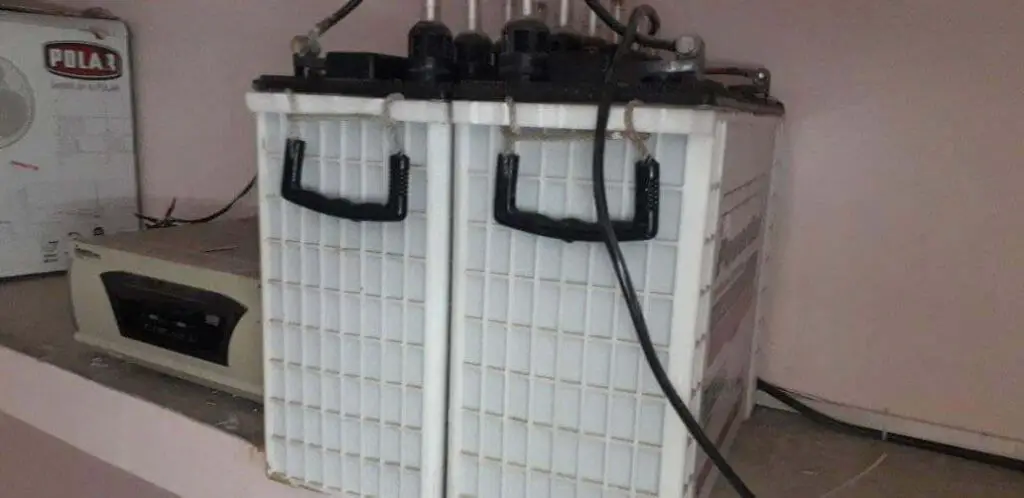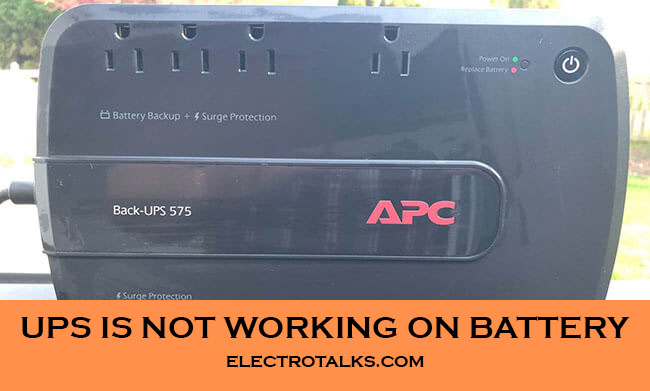“As an Amazon Associate, I earn from qualifying purchases. Without Any Extra Cost to You!”
Someone whose earning source is through doing desk jobs clearly knows the importance of UPS because power cuts can happen due to various reasons. And these power cuts happen at the worst times. Some people even work in such areas where the electricity is so bad that they need to rely on their UPS more than it is supposed to provide its service.
Eventually leads to the battery not working when there’s no electricity. You could be at an important video conference and get cut out due to your goddamn battery not providing you power.
I have had a colleague who faced this exact issue and took a tremendous financial loss. I am sure you could have this similar issue in a different field, but our common ground is the UPS is not working. Worry not, as I am here to help you with this issue.
What to look for before getting a UPS
This is to let you give an idea if you actually use a UPS, which is relevant to the activities that you do. And, also this could also help you in case you are looking for a new UPS altogether. So, let us talk about what to look for before getting a UPS:
The Devices
Clearly, you need to know which device and how many devices you will connect. Based on that, you are going to purchase your UPS. There are some UPS that can connect more than 5 or 6 devices.
Voltage and Backup time
Voltage and backup time are the purposes of using your UPS. Your primary need for a UPS is because of uninterrupted usage, even on electricity cuts. Voltage is the power that is required for better charging and preventing short circuits or rando electricity cuts, and backup time guarantees the times it will provide its backup.
A typical offline ups serve around 10-20 mins battery back up, there are also a few that provide 30 mins of backup even.
The UPS type
Based on the various types of UPSs, there are actually three types. Line Interactive, Online Double Conversion, and Offline UPS. Based on your usage, I believe you will need the Offline UPS because the other UPSs are the expensive choices that are more suitable for power devices.
Warranty Service
Warranty is incredibly important. In most cases, brands provide 2-3 years of warranty. Try looking for a brand that offers the best services and which has a battery replacement warranty.
Tools Required For Troubleshooting
- Screwdriver: You will need a screwdriver. I would suggest you get the universal ones because the screws might differ based on the UPS. You will need a screwdriver to check the battery’s condition.
- Multiplugs: A good power strip is definitely a necessity to check if it’s turning on or not. Using the typical multiplug that you have on your home should do.
- Different Pin Plugs: Based on areas, the plug of your UPS might differ. It could be three-pin, two pins, or even four pins. So, get an adapter knowing your pins and multiplug.
- Voltage Meter: While troubleshooting, you will need a voltage meter to know the condition of your battery, to know its health, and voltage basically.
Why Isn’t UPS Not Working on the Battery? (With Step By Step Troubleshooting)

Now, as we drive into solving and pointing out the issues, we need to keep in mind that some of these issues can be solved all by yourself, while a few might require either a replacement or you may need professional help. So, let us through them.
1. Lack of usage
Lack of usage can lead to your battery completely dying out. You might get the assumption that you haven’t been using your UPS for such a long time, and evidently, it should provide your expected battery backup.
But, that is the wrong understanding of it because lack of usage of your battery will degrade its battery life even further than regular usage.
The lead acids that are inside the battery are known to self-discharge, which means that the stored charge inside the batteries has been reduced.
Solution:
The key should be to charge it in a few intervals over your usage from time to time. I would suggest you charge it for 3-4 hours a day for it to stay at peak condition. This is because you don’t need to use it that much, but your no usage is creating its demise.
2. Poor Condition
A UPS, if kept under proper maintenance and suitable temperature, can serve you for over five years. Storing your UPS at the right place can definitely create an impact for your battery to not operate. More often than not, people are storing their ups under their table or beside the chassis of your pc.
People are never aware of the ups to storing it in a cool place. It is even recommended by the manufacturers as well to store in a cool place, but either you or your office isn’t aware of it.
Solution:
So, it’s simple, just store it at a place where the air is more because the thing itself always stays heated when running if it is under high temperature, then clearly, it’ll die out. It is said that for every 8-10 degrees of increment in temperature (Celsius) on average, the lifespan of a UPS declines by 50 percent.
3. Wrong cable attachment
This one is rather a rare one and has seen happen to me on my personal computer. Usually, for my computer and UPS, two main power cables are provided, and both have the same output pins.
So, I one day accidentally used the power cable of my Power Supply on my UPS, then I tried to turn my computer on. It did turn on, but when there were power cuts, the battery was not working at all.
Solution:
So, I would recommend you, if it’s your personal computer, then know the power cables, it probably will have slight distinction like the logo or the cable size. Using the correct cable might let your battery work usually unless it is too late.
4. Wrong battery placement
This is for the ones who are technical and like to get their hands inside tech. You may have wondered if you could generate more power and backup time if you change your battery into a high voltage or battery of a different power generating device. So, you changed your battery and started using it, and one day while using it, when your electricity was out, you heard a sudden surge, and your UPS blew up. Your UPS has overheated and short-circuited because of using it above the recommended timeline.
There’s no solution to it. Simply never go for this task and use your typical battery of the UPS. If battery backup is an issue for you, then go for double conversion ups that serve more time and take more load.
5. Overcharging and undercharging
To grasp this troubleshooting, you first need to know which type of battery you have on your UPS, and based on the type, your charging is affected. You could be using a battery that is lead-acid charged, which is for the general case, or the cycle batteries that are pretty rare in UPS. Lead-acid batteries are usually charged at a voltage of 13.5 -13.7VDC. As mentioned before, this lead-acid charged, and the battery’s lifespan can decline if it’s overcharged, reducing the stored charge or undercharging, which I have discussed above.
6. Green power mechanism
It could come to note that it really isn’t your battery issue, but instead, it is an issue from your settings. You could be complaining that your batteries are not giving you enough backup when you have kept your UPS on green power mode all this time.
It is basically a safety mode on your UPS where the UPS shuts down all by itself once there’s a power cut in 2 mins or so. It is basically for you to save up your work and give you room to turn off your pc.
You could even get confused about whether you are charging your UPS fully or not, then create even more problems, but the issue is in the settings.
Solution:
So, simply go through the settings and turn it off. Your UPS should start performing how you wanted it to.
7. Circuit issue
This is, I think, one of the complex ones to understand. Usually, your output devices or the devices that you will use on your UPS run on Alternating Current (AC), and the UPS itself runs on Direct Current (DC).
There is an inverter installed on the UPS that let the AC get converted to DC. If your Circuit becomes faulty, then it will fail to convert the current, which will lead to generating no power through the battery.
8. Voltage Overload
You could be wondering if your battery isn’t working when the issue could be in the voltage. Every UPS has a specific voltage limit. My UPS is 1800 volts as output, and usually, over 1/5th of volts of your UPS can lead to the UPS not giving you any battery backup. And, it results in the power failure and other problems in your ups, including your Battery.
Importance of Maintenance
You definitely need to worry about your UPS’s lifespan. And the UPS’s lifespan goes hand in hand with its battery’s lifespan. So, let me give you a few ways as maintenance methods, so you can use your UPS for prolonged days.
- It should be at all costs, it should be a place where the area is cool and dry. Make sure you do not let it go above its average temperature.
- You should be keeping replacement batteries once you know it has started to die out. But, keep in mind that batteries can be stored for up to 12 months. So, be careful in storing your backup batteries in a cool place as well.
- You should keep it charged for a specific period of time when it is idle every 48 hours.
- Unless you can skip its usage, you can let the ups run on energy-saving devices that take less power making the UPS work but also take less toll.
Frequently Asked Questions
What is the optimal temperature for UPS batteries?
For your UPS to perform regularly and for more extended periods, you must keep it at its optimal temperature. The temperature you should be keeping is around 25 degrees celsius.
Going above its optimal temperature will kill its lifespan. Like I have said before, for every 8-10 increments of temperature (Celsius) on average, your UPS’s lifespan will decline by 50%.
What is the lifespan of a UPS battery?
Depending on the brand and usage, it could vary, but on average, a UPS battery works for 3-5 years.
Wrap Up!
Thus, I hope you are clear with the idea of why your UPS battery is not working as well as knowing how to fix those couple of issues and some more insights over choosing the suitable batteries and the UPS itself. People never usually bother about a UPS’s proper usage.
They simply install it at the worst possible place and then start to complain over why it has died so early. Well, too bad the reason for it to die is more often than not you.
You need to have clarity over its usage and settings so that you are careful in using your devices around it. Hence, I hope you are now more aware than ever, and you definitely would help others with this issue.
Thank you for your patience. It has been a pleasure!
